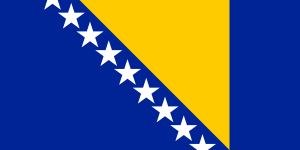Flag of Europe
The flag of Europe or European flag[note 1] consists of twelve golden stars forming a circle on a blue field. It is the official flag of the European Union. It was designed and adopted in 1955 by the Council of Europe (CoE) as a symbol for the whole of Europe.[4]
"European flag" redirects here. For a gallery of flags of countries in Europe, see Flags of Europe.Use
- Symbol of Europe
- Union flag representing the EU (27 members)
- Council flag representing the Council of Europe (46 members)
2:3
A circle of twelve five-pointed yellow stars on a blue field.
Collaborative effort involving various people, including Arsène Heitz and Paul M. G. Lévy
Since 1985, the flag has also been a symbol of the European Union (EU), whose 27 member states are all also CoE members, although in that year the EU had not yet assumed its present name or constitutional form (which came in steps in 1993 and 2009). Adoption by the EU, or EC as it then was, reflected long-standing CoE desire to see the flag used by other European organisations.[5] Official EU use widened greatly in the 1990s. Nevertheless the flag has to date received no status in any of the EU's treaties. Its adoption as an official symbol was planned as part of the 2004 European Constitution but this failed to be ratified. Mention of the flag was removed in 2007 from the text of the Treaty of Lisbon, which was ratified. On the other hand, 16 EU members that year, plus France in 2017, have officially affirmed (by Declaration No. 5224) their attachment to the flag as an EU symbol.
The flag is used by other European entities, such as unified sport teams under the rubric Team Europe.[6]





![The blue and yellow colours of the Brussels flag are those of the European Union, of which Brussels is the de facto capital city.[137]](http://upload.wikimedia.org/wikipedia/commons/thumb/b/bc/Flag_of_the_Brussels-Capital_Region.svg/225px-Flag_of_the_Brussels-Capital_Region.svg.png)
















